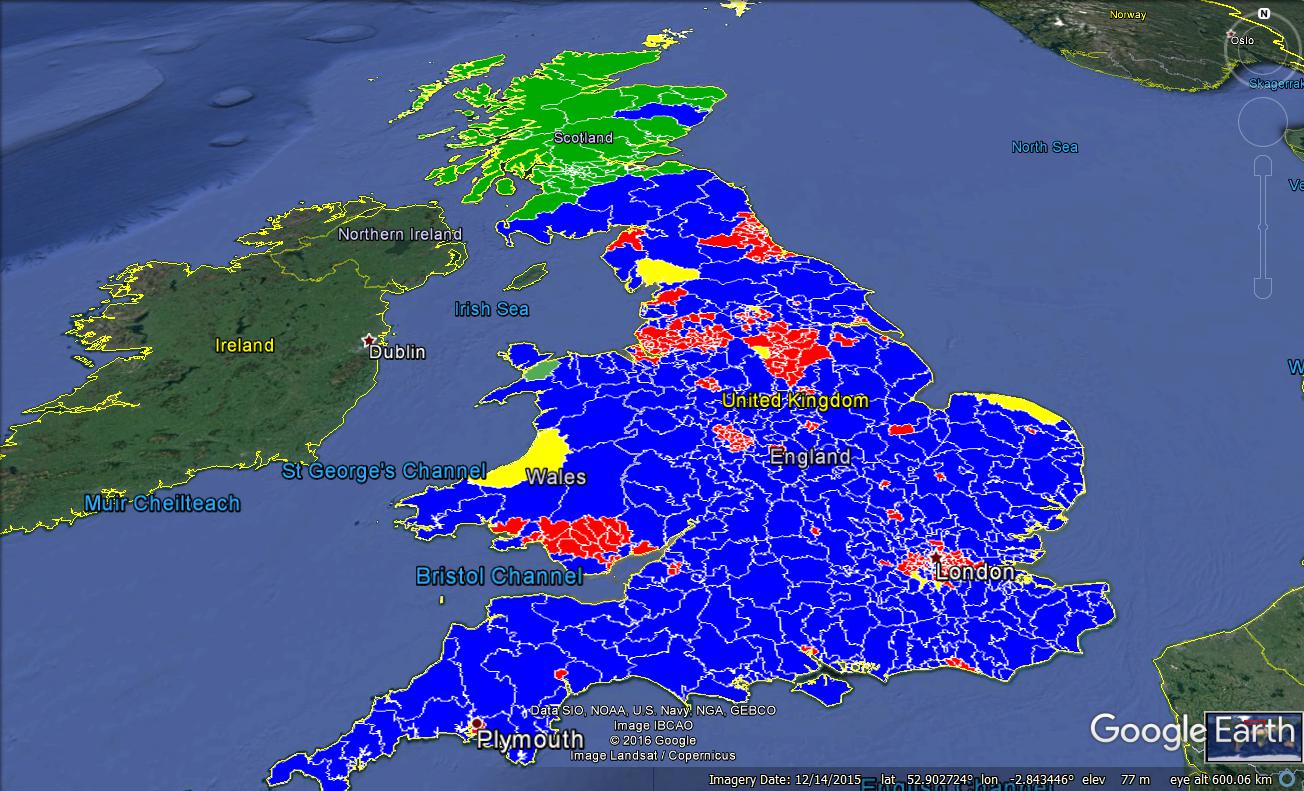The overall average (and seat totals) for the parties in the polls ending between May 16th and 20th in the UK General Election were as follows :
| CONSERVATIVES | 44% | 344 seats |
| LABOUR | 36% | 225 seats |
| LIBERAL DEMOCRATS | 8% | 9 seats |
| UNITED KINGDOM INDEPENDENCE PARTY | 4% | |
| SCOTTISH NATIONALIST PARTY | 4% | 53 seats |
| PLAID CYMRU | 1% | 1 seat |
| GREENS | 2% |

The Conservatives are up 6 points since 2015 and would gain 14 seats – however the first polls afterthe election was called suggested they would gain 125 seats. They would gain particularly amongst older voters (up 15% since 2015), working-class voters and voters in Wales and Scotland. By contrast, their vote amongst younger voters has actually dropped slightly since 2015. Their support amongst Remainers has decreased by 5 points during the campaign – their support amongst Leavers is the same. The Tories would win 125 of the 159 most middle-class constituencies, compared to 16 of the 139 most working-class constituencies. They also win 189 of the 220 constituencies with the Oldest age profile, compared to 18 of the 122 constituencies with the youngest age profile. In fact in the 182 constituencies with the youngest age profile, they lose 9 seats compared to 2015, as against gaining 22 seats in the remaining (older) constituencies. Geographically, The Tories lose 10 seats collectively in London, the South and the Midlands and gain 23 seats in the North, Scotland and Midlands.
Labour have held onto their younger vote – in fact they have significantly increased it (up 15% since 2015), but have remained largely static amongst middle-aged and older voters. They started off the campaign behind The Tories practically everywhere but now lead them in London and the North and are tied with them in Wales – which is a big improvement on the near-complete wipeout there suggested by previous polls.They are now significantly more popular amongst women than with men. Labour would win just 25 of the 159 most middle-class constituencies, compared to 105 of the 139 most working-class constituencies. They win only 15 of the 220 constituencies with the oldest age profile, compared to 93 of the 122 constituencies with the youngest age profile. Labour have gained during the campaign particularly from Female voters – The Tories led them nearly 2 to 1 at the start of the campaign, but now Labour are only a few points behind.
The Socio-economic profile of Tory and Labour voters is actually quite similar – 39% of Tory voters are working-class, compared to 42% of Labour voters. This is possibly a reflection of the increasing support Labour is winning from Remain voters. The real difference is the age-profile. Over half of Tory supporters are over 55, comparely to just over a quarter of Labour supporters, while only one sixth of Tory voters are under 35, while these younger voters account for nearly 40% of Labour voters,
The Liberal Democrats have fallen three points since the start of the campaign, and so are back at their 2015 figure. Presently, they look like making one net gain, though the line between safety and disaster is thin. They fare markedly better amongst middle-class voters (nearly three-quarters of Liberal Democrat voters are middle-class), and the vast majority of Liberal Democrats are Remain voters, due partly to a small influx of Remain voters from other parties, but also because of an exodus of 2015 Liberal Democrat voters who voted LEAVE.
UKIP entered the campaign with just over half their 2015 vote and now have less than a third of it. The majority of 2015 UKIP voters now say they are going to vote Conservative. They do best amongst working-class voters, and the vast majority of UKIPers are Leave voters.
The SNP would still retain a huge majority of the seats in Scotland, even though their vote is down somewhat.
The Conservatives been very successful in retaining their 2015 voters, with 9 out of 10 saying there are sticking with them. In addition over half of 2015 UKIP voters and 1 in 6 2015 Liberal Democrat voters (and 1 in ten 2015 Labour voters) are now intending to vote for the Conservatives. Of Particular interest is that, despite the fact that the Conservatives are implementing Brexit, they are managing to hang on to more than 5 out of 6 of their 2015 voters who voted REMAIN in 2016 (source : ICM polls). This compares to Labour only currently retaining 2 out of 3 of their LEAVE voters, and the Liberal Democrats only retaining 1 out of 3 of their Leave Voters.
At the time of the Brexit Referendum The Tories were virtually tied with UKIP amongst Leave voters – they started this campaign 50 points ahead of them, and have strengthened this lead reflecting polling showing that the bulk of 2015 UKIP voters are now intending to vote Conservative. By contrast, The Tories started the campaign again virtually tied with Labour amongst Remain Voters – but have now fallen significantly behind them amongst this cohort.
You can download the report here : UK May 21 to May 25